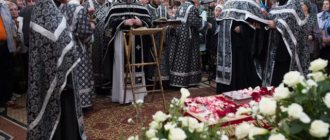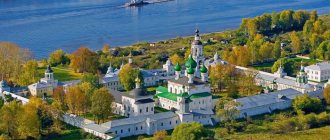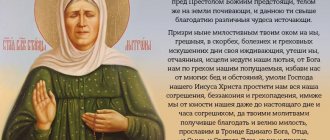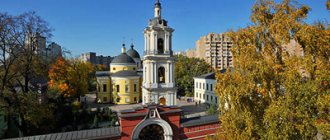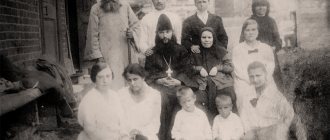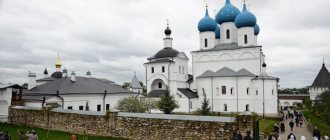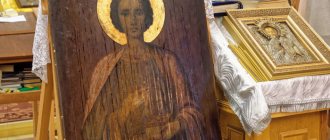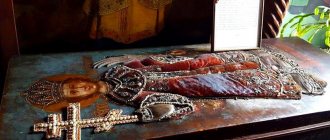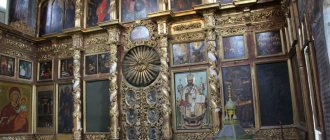One of the most beloved holy images in Christianity is the divine image of the Great Martyr. He was sentenced to execution as soon as he publicly said that he professed the Orthodox faith. In our article you can familiarize yourself with the short life of the Martyr, and also find out what role the icon of the Saint plays in Christianity, and in what cases people ask for help in front of it. Dear Brothers and Sisters, we will be very glad if you subscribe to our VKontakte group, there you will find even more prayers, icons and other interesting information, here is the address link - Orthodox group! We are also pleased to remind you that on the pages of our Orthodox store you can find all possible Orthodox products!
Life of St. Demetrius
God's Pleasant was born in sunny Greece in the small town of Thessaloniki, during the reign of the pagans - the atheists Diocletian and Maximian.
His father and mother were unable to conceive a child for a long time. His parents were hidden supporters of Orthodoxy, and they continuously read prayers before the image of the Almighty for the sending of a child to them. The Almighty heeded their prayers and the mother soon became pregnant. When the boy grew up a little, his mother and father brought him to the house of the holy father under cover of darkness to perform the baptismal ceremony. Throughout their worldly life, the parents taught their son Christianity. The boy's father worked as a professional master. When he reached adulthood, his father died. The ruler of Greece, Maximian, issued a decree appointing Dmitry as the leader of the punitive forces against Orthodox believers. In the course of his activities, the Saint was obliged to ensure the protection of the Thessalonian region and exterminate Christian believers. But in fact, the Ascetic began to convert pagans to Orthodoxy.
When all this reached Maximian, he ordered him to be thrown into prison. But while in captivity, the Great Martyr did not abandon his commitment to Christianity, but instead began to praise Jesus Christ even more fiercely. During the reign of Emperor Maximian, entertainment such as the circus and gladiator fights were common. But during one fight, the emperor’s favorite gladiator dies, and Maximian becomes enraged and gives the order to kill the winner.
But this did not satisfy the emperor, and he ordered Dmitry to be executed. At dawn on the twenty-sixth of October in 306, soldiers came for the prisoner in order to take the Great Martyr to execution. But when they entered the cell they found the Saint praying to the Lord, and then the soldiers immediately stabbed him to death.
His body was thrown out to be eaten by animals, but his supporters took the body and buried it. After which the servant of Saint Lupp took the bloody clothes and ring and gave healings from illnesses to all the sick, for such activities he was also executed.
Thirty-two years after the death of Dmitry, a cathedral was erected over his burial place, in which many believers found deliverance from all suffering. After some time, the holy remains of the Great Martyr were found. Dear Friends, we remind you that buying an icon of Dmitry of Thessalonica is easy and inexpensive in our icon catalog!
Folk signs on November 8:
- The dawn is painted crimson - the wind will howl.
- If frost is visible in the morning on November 8th, there will be a lot of snow in winter.
- This day was used to judge Easter and spring in general. If a lot of snow falls, it will not melt on Easter.
- If it is cold and snowing on Dmitri’s Day, then spring will come into its own late and will be cold.
- If there is a thaw outside the window, then the weather will be warm all winter and spring.
- By this day, the rivers had not yet covered with ice - there would be no frost until the end of November.
- If a girl has not gotten married before this day, she will continue to be a wench for a long time.
- If it thaws on Dmitry, all of Mother Winter will be left with wet greenhouses.
- Dmitriev does not wait for the day of transportation.
- It won't be winter until Dmitry's Saturday.
- In November, warmth and frost are not a decree.
- November will not be ashamed - it will beckon you with warmth, but it will hurt you with hail.
- If you notice that the stars flicker with a reddish or blue light at night, the bad weather will drag on for a long time.
- In the morning there is a lot of frost on the tree branches - frequent snowfalls are expected in winter.
- Cold and snowy - spring will come late and will not please you with good weather.
- If the skin on the bulbs is very thick and does not tear easily, then the winter will be frosty with frequent snowstorms.
- Ice has not yet appeared on the rivers, which means that cold weather will not set in until the end of November.
Sun, 08 Nov 2022 00:20:20 +0300
@ Kulyomina Ksenia, esotericist
Meaning of the icon
This holy image is considered the strongest talisman of everyone involved in military affairs. The figure of the Great Martyr of Thessalonica played a huge role in the development of Christianity in Kievan Rus, along with the holy image of Dmitry Donskoy. These two shrines are considered an attribute of masculinity and courage. In the chronicles there is a mention that during the celebration of the Liturgy, the king was also in the temple before the face of the Righteous One.
After the Battle of Kulikovo, in honor of all the fighters who laid down their lives in this battle, Dmitrievsk Parental Saturday was established in order to hold a joint memorial service. From that day on, they began to praise the face of the Great Martyr on Saturday and the twenty-sixth of October, when the remains of the Saint were found. The first time such a service was held was on the twentieth of October at the end of the thirteenth century.
Troparion, kontakion, magnification
Troparion of the Great Martyr Demetrius of Thessalonica, tone 3:
Great will you find in troubles, the universe, the passion-bearing champion,/ conquering tongues./ Just as you laid down pride for Leah,/ and boldly created Nestor for the feat,/ so, Saint Demetrius,/ prayed to Christ God// grant us great mercy.
Kontakion of the Great Martyr Demetrius of Thessalonica, tone 2:
With streams of your blood, Demetrius, / God stained the Church, / giving you an invincible fortress, / and keeping your city unharmed, / / of that you are the affirmation.
Prayer to Dmitry of Thessalonica read online
The holy and glorious Great Martyr of the Lord Demetrius, quick helper and merciful protector, we turn to you with confidence! Having presented yourself with courage before the Heavenly Lord, beg Him to grant forgiveness of our sins and deliverance from evil temptations, cowardice, water, fire, war and eternal suffering. Beg the Heavenly Lordship to send blessings on this city, on this monastery and on any Orthodox state.
“Pray Our Lord to grant victory to Orthodox Christians over their enemies, to every Christian country peace, tranquility, unshakable faith and success in righteousness; For us, who praise your holy name, ask for a blessing in doing good and righteous deeds, the deeds performed on earth by our Savior Jesus Christ, we will be worthy through your prayers to inherit the Kingdom of the Lord for the eternal praise of the Father and the Son and the Holy Spirit. Amen."
Varieties of Saint icons and their descriptions
The most beloved icon of Christians is the image in which the Great Martyr of Thessalonica is depicted in the saddle. This image depicts a miraculous act, which is described in the legend of Dmitry Donskoy. According to legend, at the beginning of the twelfth century, an army led by Emperor Kaloyan tried to capture the city of Thessaloniki. But the Righteous One appeared in the invaders’ camp and executed the king: • In the image, he stabs the invader, and he goes underground. • On the gates of the city warriors and ordinary people are depicted holding the face of the Ascetic in their hands • The heavenly messenger of the Lord appears in the sky and places a crown on the head of the Righteous One. • And on the left from Heaven the Lord bestows his blessing on the holy protector.
Another fairly famous icon is the face of the Saint from the twelfth century; in our time, this shrine is kept in the Tretyakov Gallery. It is believed that this face was painted in the twelfth century and was kept in the city of Dmitrov in a temple, but after the end of the revolution the icon was taken and given to the museum. In the early twenties, icon painters scraped off the top image, painted on top of the ancient one. The icon painters saw the face of the Great Martyr sitting on a throne with a crown on his head, holding a sword in his hands. Undoubtedly, in the Heavenly Kingdom there is no need for protection; this is an attribute of the fact that during worldly life he was armed with the Holy Word. It is believed that this is a symbol of courage and bravery.
Public Defender
It is generally accepted that the face of the Great Martyr heals those who suffer from ailments of the head and eyes. In addition, Ugodnik is a protector of the military. When found, the remains of the Great Martyr poured out a large amount of aromatic oil, which is why it was called myrrh-streaming. Christians use the fragrant oil to get rid of all ailments. In Kievan Rus, the Righteous One was so revered that he was considered Russian by birth. Even royal nobles very often named their sons after the Holy Warrior, which probably explains the prevalence of his name, which has survived to this day.
From service for the emperor to execution - one step
What was required of the young proconsul? Protecting the borders of the empire from external enemies, organizing the activities of military commanders. But the emperor entrusted his subject with a new task: to fight Christians.
Dmitry of Thessalonica did the opposite: he began to enlighten the pagans with the faith of Christ. This was an open challenge to the emperor. Maximian did not tolerate such insolence and imprisoned the proconsul.
Dmitry knew perfectly well what awaited him for openly professing Christianity, and even before prison he gave away all his property. It is not known how long he would have spent in prison if he had not agreed to the second insolence. And this was its meaning.
Emperor Maximian organized gladiatorial fights, pitting his proud opponent Leah against the Christians. No one could defeat him on their own. But the Christian youth Nestor, hoping for God's help, came to the imprisoned proconsul and asked for a blessing. Dmitry of Thessalonica blessed Nestor and asked the Lord for help. So the young man defeated the arrogant Leah, throwing him on military spears.
Maximian avenged the death of his favorite by executing Nestor. And when he found out from whom the young man received the blessing, he ordered his adviser to be killed as well.
On November 8, 306, in the early morning, Maximian’s servants arrived in prison. They found Dmitry at morning prayer and pierced him to death with spears.
Childhood and youth of the great martyr
Great Martyr Demetrius of Thessaloniki was born in the 3rd century in the Greek city of Thessaloniki (modern Thessaloniki). In Rus' this settlement was called “Solun”. Hence the name of the saint “Thessalonica” and many versions that the great martyr was Russian. But they are not true.
We advise you to study Prayers for your son’s drunkenness
At the time when Dmitry lived, Thessalonica belonged to the Roman Empire, and the saint's father was a Roman proconsul. Since Christianity was not yet an official religion, the parents secretly baptized their son in their home church and raised the boy in the Christian spirit.
The emperors of that time - Diocletian and Maximian Galerius - supported paganism and persecuted Christians. If they knew that the proconsul in Thessalonica was a follower of Christ, then the father of the future great martyr would hardly have remained in his position and died a natural death.
But the secret was kept, and even after the death of the Thessalonian proconsul, the authorities did not know about his Christian views. Maximian established Dmitry of Thessaloniki, who had already reached the age of majority, to take over the position of his father.
What do they pray for?
- The holy prince is asked for intercession.
- People who have suffered from slander, slander and other hostile actions cry out for his help.
- They pray to him for the resolution of various kinds of conflicts.
- They ask for protection of the house and property from robbers.
- The holy prince-spouses Demetrius Donskoy and Euphrosyne of Moscow are asked for prosperity in family life and mutual understanding between children and parents.
How does a saint help through prayer in front of his image?
- The saint helps to reconcile the warring parties.
- And also protects those who come to him from all kinds of temptations.
- The prince is revered as a prayer book for Rus', protecting its borders from enemy invasions.
- He is also considered a zealous defender of the Orthodox Faith.
How Saint Prince Alexander Nevsky is depicted on icons
Iconography
From ancient times in Rus' it was customary that the great martyr especially patronized soldiers. On icons he is often depicted in armor. In his hands he usually holds a spear and a sword.
Prince Dmitry Donskoy often turned to the righteous man with prayers. It is known that before the battle on the Kulikovo Field, his image, written on a board from the coffin, was brought to the Assumption Cathedral in Moscow. Soon, a funeral service was held in honor of the soldiers who died at the Battle of Kulikovo. Since then, on the eve of the feast day of St. Demetrius, which falls on November 8 (October 26, old style), it has been customary to commemorate deceased ancestors. This day is known as Dmitrievskaya Parents' Saturday.
A well-known mosaic icon of the Great Martyr (12th century) from the Cathedral of the Dimitrievsky Monastery (Kyiv). Now it is located in the Tretyakov Gallery (Moscow). The righteous man is depicted on it in full growth. With one hand he leans on a shield, and in the other he holds a spear. A sword is visible behind his back.
Dmitry Solunsky School or art. center: Kyiv 1108 Antonova, Mneva 1963: Approx. 1113 223 × 132.5 cm State Tretyakov Gallery, Moscow, Russia Inv. 25532
The icon depicting the Great Martyr on horseback is especially revered by Christians. He thrusts a spear into the pagan king Kaloyan, who wanted to capture the hometown of the righteous. The defeated invader goes underground. This event is described in the legend of Dmitry Donskoy.
Miracle of Demetrius of Thessalonica End of the 17th century. 37 × 34 cm Museum of Fine Arts of the Republic of Karelia, Petrozavodsk, Russia Comes from the village of Tambitsy, Medvezhyegorsk district.
Russian squad
Dmitry Donskoy's warriors were professionals in their field. They spent their whole lives in campaigns and battles, they knew military affairs thoroughly, including the Tatar equestrian system. They were well equipped, protected by strong and flexible chain mail. Helmets with aventails on their shoulders shone in the sun - that is, with chain mail nets that protected the warrior’s neck. And Dmitry had a lot of them - 20 thousand! With such a “forged army,” the prince could count on victory.
The prince transformed military tactics. Detachments of “watchmen” conducted reconnaissance and reported on enemy movements. The commanders skillfully inflicted unexpected blows on the enemy.
Miracles
Objects soaked in the blood of the great martyr helped people heal. The same miracles were shown at the saint’s burial place. Eparch Leonty received healing after lying on the grave of Demetrius. He ordered a temple to be built over the burial site.
The miracles revealed at the grave, as well as from Demetrius’s belongings, were first described in the 7th century by Archbishop John. Many of them are associated with healing, others with help in military affairs:
- It is known that one eparch could not be cured by healers; he refused to use amulets. Demetrius, who appeared in a dream, ordered him to go to the temple, after which the sufferer recovered.
- In the temple above the grave of the saint, a warrior was freed from demons, whom they could not otherwise bring to his senses.
- By order of someone who wanted to receive part of the emperor’s relics, they tried to open the saint’s tomb. But Dimitri’s voice forbade this, and the workers were thrown away from the grave.
- During the siege of Thessalonica, the city was threatened by the Bulgarian Tsar Kaloyan. It is believed that Demetrius appeared to him at night and stabbed him with a spear. The army left without a leader.
- During the siege by the Avars, the saint in shining armor appeared on the walls of his native city and himself repelled the attack. The warrior who went to the temple witnessed such a miracle - Demetrius stood in the church in a bright glow, the angels persuaded him to leave the besieged city. But the saint refused. He helped his fellow countrymen defeat the formidable army, and sent ships to the harbor to save the townspeople from hunger. Since then, he has been considered the heavenly patron of the city of Thessaloniki.
- The deliverance of the city of Thessalonica from the plague through the prayers of Saint Demetrius dates back to July 586.
Many miracles are associated with the name of the saint in our country. The chronicler Nestor wrote that Prince Oleg’s campaign against Constantinople was successful due to the patronage of Saint Demetrius, who helped the Russian soldiers.
Information: the veneration of the Great Martyr by the Orthodox began immediately after the baptism of Rus'. Serbs and Bulgarians, Russians consider Demetrius of Thessaloniki the patron saint of the Slavic peoples.
How they portray
Artists
Many Russian painters turned to the theme of the heroic battle on the Kulikovo Field.
Ilya Glazunov
In 1962, the artist began painting a number of canvases united by the theme of the Battle of Kulikovo. This work continued for 30 years.
Ilya Glazunov. Eve. Sergius of Radonezh and Dmitry Donskoy before the Battle of Kulikovo. From the series “Kulikovo Field”. Option-repetition. 2004
Painting "Prince Dmitry". The artist depicts Dimitry Ioannovich before the battle. The prince's face is calm and expresses confidence. However, the crimson color of the cloak and the sharp spears behind his back convey the general anxiety of the plot of the composition. The high mission of the Russian soldiers is figuratively emphasized by the background of the canvas chosen by the master, which represents a cloudy blue sky, symbolizing the purity and nobility of the goal of those fighting for the freedom of the Fatherland.
“They found Prince Dmitry”
Another painting from the “Kulikovo Field” series. The plot of the film is based on the events that occurred after the battle, when a wounded prince was found among the fallen soldiers.
The artist himself explains that in his creations he sought
Ilya Glazunov. Cycle “Kulikovo Field”. Dmitry Donskoy. 1980.
“St. Sergius blesses Demetrius Donskoy”
The painting was painted by the painter in 1882. At that time, he was completing his studies in the life class of the St. Petersburg Academy of Arts. For this programmatic work, which reliably reproduces the events of that distant era, the exact setting and psychological portrait of the participants, Alexander Nikanorovich Novoskoltsev received a large academic medal.
At the beginning of the 19th century. The professorship of the Academy of Arts proposed this topic to its graduates as a thesis. Orest Kiprensky then received a gold medal for the painting “Dmitry Donskoy on the Kulikovo Field,” created in 1805.
Vasily Sazonov
In 1824, a canvas with the same name was depicted by the artist Vasily Sazonov. Although his work was not realistic and did not fully correspond to the national color, it forever entered the golden fund of works of Russian academic painting.
Temple paintings
Franz Nikolaevich Riess
In the middle of the 19th century, the Russian painter Franz Nikolaevich Riess completed some wall paintings in the northwestern part of St. Isaac's Cathedral, including a depiction of a majestic scene of the blessing of Demetrius Donskoy by Abbot Sergius of Radonezh. This work of the great master adorns St. Isaac's Cathedral to this day.
Yvon Adolphe
Adolf Yvon. Battle of Kulikovo Field, 1850
In 1850, by order of Nicholas I, the French battle painter Yvon Adolphe created a monumental canvas called “The Battle of the Kulikovo Field”, the central part of the composition of which is occupied by the image of St. Prince Demetrius in the midst of the battle. It was planned that this creation would decorate the lower corridor of the Cathedral of Christ the Savior, but events changed, and today the painting adorns the flight of stairs leading to the St. George Hall of the Grand Kremlin Palace.
Frescoes
Annunciation Cathedral of the Moscow Kremlin. On the pillars above and below the illustrations of the Apocalypse are figures of saints - Byzantine emperors and Russian princes, including Prince Dimitri Donskoy and his son Vasily. Work of Pskov craftsmen commissioned by Ivan III Vasilyevich, 1484-1489.
The oldest fresco depicting the prince together with his son Vasily is located in the Annunciation Cathedral of the Moscow Kremlin. It was made at the beginning of the 16th century. artist Feodosius. A later fresco, created in the second half of the 16th century, is located on the southern wall of the Archangel Kremlin Cathedral. On it, Dimitri Ioannovich is presented among other Moscow rulers.
The image of the prince can be seen on a fresco of the late 17th century. in the Transfiguration Cathedral of the Novospassky Monastery, as well as on the central vault of the front vestibule of the Moscow Historical Museum. The last image was made in 1883 by the artel of F.G. Toropova.
Having become one of the eight most significant figures in national history, Dmitry Donskoy is represented on the middle tier of the monument “Millennium of Russia”
Relics
The saint's grave has been revered since the time of his burial. Many legends testify that those who came to pray heard a voice sounding from the ciborium and turned to it with requests. Sources from the 7th century report that when the relics were removed from the burial place of the saint, everything around was fragrant with a wonderful aroma, and myrrh was released abundantly. Deep veneration of the relics and blood of Demetrius of Thessalonica developed by the 10th century. The myrrh flow was so abundant that everyone took the precious liquid, used it to treat wounds, and added it to food.
Pilgrims collected myrrh and took it to their lands in vessels. Over time, the silver ciborium was replaced with a marble one, and a double sarcophagus was built for the relics. Before dangerous battles, warriors covered their bodies with myrrh. Icons of Demetrius were made with a small vessel for the precious liquid. With the arrival of Muslims in Thessaloniki and the transformation of the basilica into a mosque, the flow of myrrh stopped.
The burial site was plundered during the Crusades. The relics were taken to Italy. For a long time they were kept in the Abbey of San Lorenzo in Campo. At the end of the 20th century, the relics returned to Thessaloniki. The relics of the saint left Greece more than once; they could be venerated in different countries of the Christian world. Raku was brought to Moscow and Yekaterinburg.
Iconography
From ancient times in Rus' it was customary that the great martyr especially patronized soldiers. On icons he is often depicted in armor. In his hands he usually holds a spear and a sword.
Prince Dmitry Donskoy often turned to the righteous man with prayers. It is known that before the battle on the Kulikovo Field, his image, written on a board from the coffin, was brought to the Assumption Cathedral in Moscow. Soon, a funeral service was held in honor of the soldiers who died at the Battle of Kulikovo. Since then, on the eve of the feast day of St. Demetrius, which falls on November 8 (October 26, old style), it has been customary to commemorate deceased ancestors. This day is known as Dmitrievskaya Parents' Saturday.
A well-known mosaic icon of the Great Martyr (12th century) from the Cathedral of the Dimitrievsky Monastery (Kyiv). Now it is located in the Tretyakov Gallery (Moscow). The righteous man is depicted on it in full growth. With one hand he leans on a shield, and in the other he holds a spear. A sword is visible behind his back.
Dmitry Solunsky School or art. center: Kyiv 1108 Antonova, Mneva 1963: Approx. 1113 223 × 132.5 cm State Tretyakov Gallery, Moscow, Russia Inv. 25532
The icon depicting the Great Martyr on horseback is especially revered by Christians. He thrusts a spear into the pagan king Kaloyan, who wanted to capture the hometown of the righteous. The defeated invader goes underground. This event is described in the legend of Dmitry Donskoy.
Miracle of Demetrius of Thessalonica End of the 17th century. 37 × 34 cm Museum of Fine Arts of the Republic of Karelia, Petrozavodsk, Russia Comes from the village of Tambitsy, Medvezhyegorsk district.
We advise you to study the Exaltation of the Holy Cross: pictures, postcards
